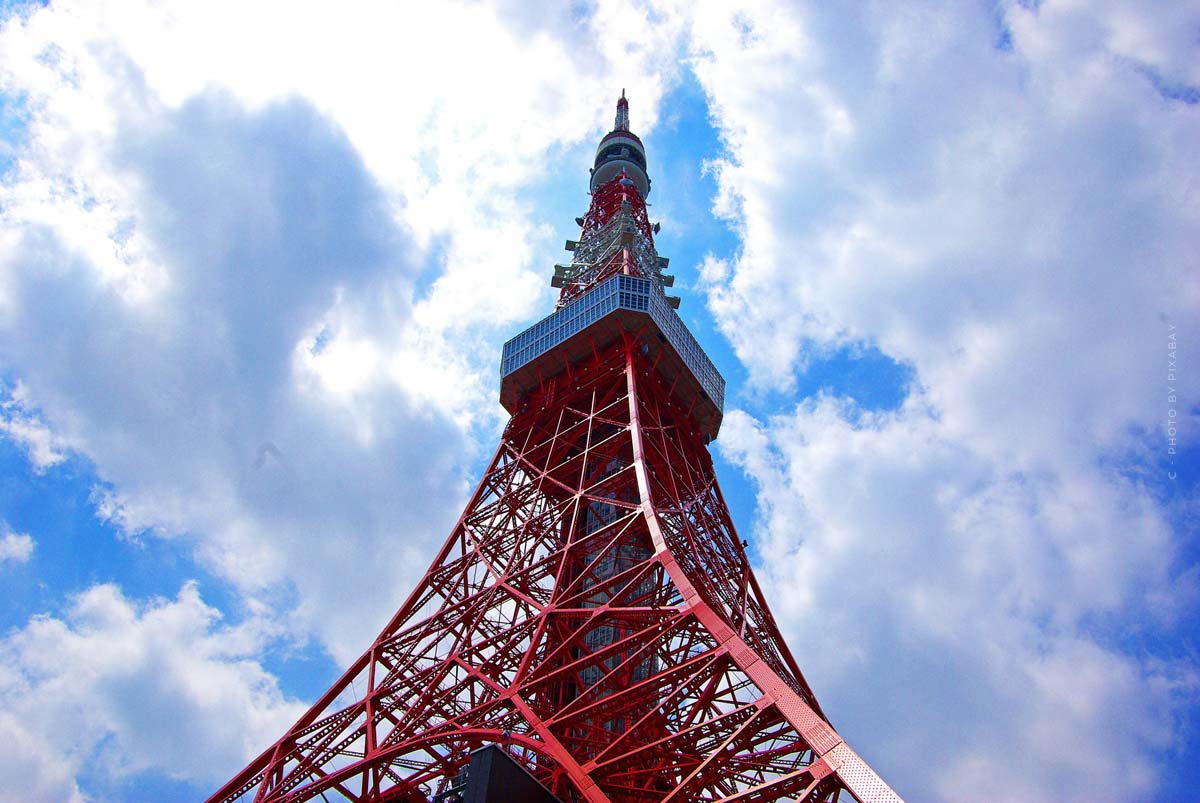Experience Tokyo: Travel tips & experience reports from Adachi to Taitō
As one of the best-known metropolises in eastern Asia, Japan’s capital Tokyo is well known to almost everyone. But how many different faces Tokyo has, one learns only if one has been there once. In the city centre, the city is brightly lit – the view from the many billboards, billboards, company logos and lights is almost impossible to turn away – and lively. People are everywhere, determined on their way to work, school, university or happily dancing to the current charts in the subway shaft. Tai Chi in one of the city’s numerous parks, street artists, men and women in kimonos, small children in panda costumes – the people in Tokyo are as multifaceted as their city. Read more about Japan’s metropolises Kyoto and Kobe.
Tokyo through the ages
Today, more than 9.5 million people live in Tokyo, but if you look back only a few centuries, there was nothing but a small settlement with a fishing port called Edo. By the way: its roots even go back to the Stone Age! In the 15th century a castle was built near the settlement, but the present world metropolis only gained historical importance at the end of the 16th century, when Shogun Tokugawa Ieyasu took possession of the settlement and castle and a few years later in 1603 became the capital of his shogunate. As the seat of the Shogunate, the city of Edo underwent numerous changes and changes until Emperor Mitsuhito moved from Kyoto in the middle of the 19th century and renamed the city – now home to around 1 million inhabitants – the “imperial residence city in the east”, i.e. Tokyo. Tokyo is now a real cultural metropolis with numerous theatres, museums and parks, yet it has never forgotten its origins. Thus, in addition to the numerous modern blocks of buildings that tower up into the sky, historic buildings and temples are also lined up everywhere. It is an unusual and unique harmony between modernity and antiquity, so typical of Tokyo, and is also reflected in the two largest and most important sights of the city: the old Imperial Palace and the Tokyo Tower with a height of 333 meters.
Drone flight – sight seeing over the rooftops of Tokyo
Tokyo’s 23 boroughs and their special features
Adachi – impressed with large Senju bridge
A small district in the north of Tokyo. An important sight is the large Senju Bridge, which connects the individual areas within the district.
Arakawa – directly on the banks of the Arakawa River
This district is named after the river of the same name.
Bunkyō – Location of the World-class University of Tokyo
The educational district of Tokyo with numerous educational institutions and sights, including the University of Tokyo and the Tokyo Dome.
Chiyoda – from Imperial Palace to Sega World
The administrative district and headquarters of numerous large companies. Here you will find the imperial palace, the old castle Edo and many other historical buildings. Chiyoda also has the famous Akihabara entertainment district, the heart of the Japanese electronics trade and THE place to go for all fans of video games, anime and manga – the eight-story Sega World is just one example of many. Cosplay cafés and fan meetings are the order of the day here and the last celebrants often leave Akihabara only the next morning. Chiyoda is one of Tokyo’s least populated districts, but during the day there are 20 times as many workers and commuters here!
Chūō – extensive shopping in Ginza
One of Tokyo’s main business centres, including Ginza (THE shopping and entertainment district in Tokyo!) and the famous Tsukiji fish market.
Edogawa – birthplace of trend musician Kazuya Kamenashi
Named after the nearby river and hometown of Kazuya Kamenashi, member of the successful J-pop band KAT-TUN.
Itabashi – medical pioneer of Nihon University
Tokyo’s industrial district with business district in the north and four large universities, including the medical faculty of Nihon University
Katsushika – Residence of over 400,000 Japanese
This district was originally a union of several villages and small towns and now provides mainly housing for the population of Tokyo.
Kita – attractive for young & old: Asukayama Park
Although this is one of Tokyo’s smallest districts, it is also one of the most populous with 80% of the population. Next to Akabane railway station is Tokyo’s first public park, Asukayama Park.
Kōtō – world important exhibitions in the Tokyo Big Sight
The Tokyo Big Sight international exhibition hall and the Toyko Gate Bridge are located in this district, which was largely built by reclaiming new land.
Meguro – full of diplomats & embassies
A combination of a residential area and diplomatic quarter. It is the seat of numerous international embassies, especially of the West Asian countries and Africa, but also of the Honorary Consulate General of Iceland.
Minato – Tokyo Tower, Tokyo Midtown & Roppongi
In addition to a large number of educational institutions, some sights such as the Tokyo Tower and the Toyko Midtown high-rise complex with the highest skyscrapers in the city as well as the luxury district of Roppongi can be found here. Minato is also home to the tech companies Sony, Toshiba and NEC Corporation.
Nakano – divided into 18 individual districts
This district consists of 18 districts and is divided by several rivers. Nakano is connected to the subway network, but has no motorway of its own.
Nerima – over a hundred years of carousel
In this district there are mainly residential buildings and individual parks. In the Toshima-en amusement park you can marvel at the oldest still operated carousel in the world – it was put into operation for the first time in New York in 1910!
Ōta – Temple complex Homon-ji from the 13th century
This is the largest district in Tokyo and the third largest in terms of population. Here you will also find the famous Homon-ji, a Buddhist temple from the 13th century.
Setagaya – Luxury district with over 800,000 inhabitants
This is by far the most populous district of the city. Of Tokyo’s more than 9 million inhabitants, over 800,000 live here in Setagaya. It is one of the more expensive residential areas with about 60% pure residential development. The Carrott Tower with a height of 124 meters is also here.
Shibuya – Shopping & Fun in Shibuya
The Shibuya entertainment district is part of the district of the same name. The shopping street Senta-gai is one of the most popular shopping opportunities for Tokyo’s young population. The world famous statue of Shiba Inu Hachiko stands directly in front of Shibuya station. By the way: due to the mass of information technology companies Shibuya is often called Bit Valley!
Shinagawa – 6,000 hotel rooms near the station
A variety of universities and offices are located here in Shinagawa. However, due to the highest concentration of hotels and accommodation in Tokyo, the district attracts special attention with 6,000 rooms around Shinagawa station alone!
Shinjuku – bigger, nicer, better
Shinjuku station in Tokyo is one of the stations with the highest passenger volume in the world! But everything else in Shinjuku is bigger, better or more successful: Japan’s most important commercial and administrative centre is here, as is the largest shopping district in the whole of Japan, Japan’s largest and oldest entertainment district… Yayoi Kusama, one of the most important Japanese artists of the post-war period, had her own Yayoi Kusama Museum built here. By the way: Shinjuku maintains a partnership with the Dongcheng district in Beijing and the Mitte district in Berlin.
Suginami – Education in over 100 institutions
This district is mainly a residential area with only a few industrial settlements. There are 47 primary schools, 32 secondary schools, 21 secondary schools, 6 universities and 11 libraries!
Sumida – Sumo & Sumida Hokusai
Sumida is also mainly populated by people. There are several museums here, including the architectural Sumida Hokusai Museum and Ryogoku Kokugikan Sumo Hall.
Toshima – International in Tokyo
About 47% of this district consists of a residential area, in addition there are public places and some commercial enterprises. With a non-Japanese population of about 15,500 people, Toshima is one of Tokyo’s international districts. Here, too, there are several educational institutions, including the Tokyo Conservatory of Music.
Taitō – Sumidagawa-Hanabi, the biggest fireworks festival
In Taito there are the entertainment districts Asakusa and Ueno. The National Museum of Western Art, the Daimyo Clock Museum and the Ueno-Zoo are just some of the places to visit for culture and entertainment. Taito is also a popular place to celebrate Sumidagawa-Hanabi, Japan’s largest fireworks festival, and Sanja-Matsuri are both held here every year.
The travel guide for Tokyo
Holidays Extras Travel Guides explains the easiest and most convenient way to travel to Japan and what sights and attractions you should not miss on your first visit to Tokyo.
The Tokyo Metro – immortalized on a Nike sports shoe
Nike has drawn inspiration from the world’s major cities in creating the new Air Max series. The Tokyo Metro’s labyrinth-like rail network is reflected in the “Tokyo Maze” model and also gives its name to the new sports shoe.
Luxury life Tokyo – the most expensive apartments in the world
Living in Tokyo is a costly thing – especially the house prices are horrendous, one is not satisfied with the absolute minimum. In Ginza, for example, for a 13m² apartment you can expect about 800,00 Euro per month, for 50m² in Shibuya even between 2.500,00 Euro and 3.000,00 Euro per month and in Akihabara a monthly rent of 1.200,00 Euro for a 35m² apartment is a real bargain!
Between pressure to perform and late pension
That is perhaps why the people of Tokyo are particularly ambitious. Demands on academic and professional performance are high, which is particularly noticeable to the children time and again. You have to be diligent and work hard later so that your own children will have a better time. Only the factor of public school or private institute has a decisive influence on future careers. The pressure of expectations to which people here are exposed – both in their private lives and in society – means that everyone works late from morning to night, a 40-hour week plus 40 hours of overtime per month is the standard here and an after-work time after 11 p.m. is not uncommon. This is very harmful to Japanese health, and people are retiring very late – at 67 years of age – but on average the Japanese are getting much older than anywhere else in the world.
Creative outburst of opposites
In this context, it is understandable that the people in Tokyo sometimes seem a little chilly – like ants driving them from one place to another, always purposefully, always focused – like little wheels in a gear. There is no time for a nice smile or an apology and the necessary energy for it is better spent on more work. Nevertheless, the lifestyle in Tokyo in particular is rich in contrast, colourful, loud and shrill. There is nothing that does not exist – and what does not exist is probably invented here! This principle is reflected in music, art and, of course, fashion. From elegant women and men in kimonos to doll-like Lolitas with lace umbrellas to young men in flashy designer suits and colourful streetfashion – the main thing is to stand out. But of course there are also the normal suit and costume wearers as well as the students in their uniform uniforms – a surreal mix, especially if Spiderman and Sailor Moon are walking around the corner, closely followed by an adult in a Pikachu costume.
Impressions from Style ID: Tokyo Fashion Week A/W 18/19
A short impression of the last Fashion Week in Tokyo with designs for the autumn-winter collection of the year.
Designer Tokyo
Dice-K with its GlamHate brand is a prime example of a young Tokyo designer who once again redefines the term fashion for himself and takes up elements from GlamRock, vampirism and Lady Gaga’s stage outfits. His current collection VAMPYRE has been running for several weeks and is aimed specifically at Japan’s youth scene.
Tokyo – overwhelming and beautiful
All in all, Tokyo is definitely worth a trip – one should only plan enough time to take in all the different impressions. In seven days, not even a 100th of what the world metropolis has to offer! Fortunately, there is a sophisticated and 100% reliable rail network that transports you from one district to another in the shortest possible time. Only during rush hour it is hard to stand in the Tokyo Metro, so you shouldn’t have any fear of contact and claustrophobia. As an alternative to the subway’s local trains, there are also the Shinkansen, the famous Japanese high-speed trains with a network across Japan and an impressive top speed of up to 320km per hour. Aomori, Kyoto, Osaka, Yokohama and Sapporo and many other cities are only a stone’s throw away.
More about Japan: Travel tips for vacation or weekend
Tokyo is of course not the only beautiful city in Japan. The Land of the Rising Sun has several other exciting, colourful and fashionable cities to offer with unforgettable sights and events. Of course, we have already compiled more information about Japan for you:


























